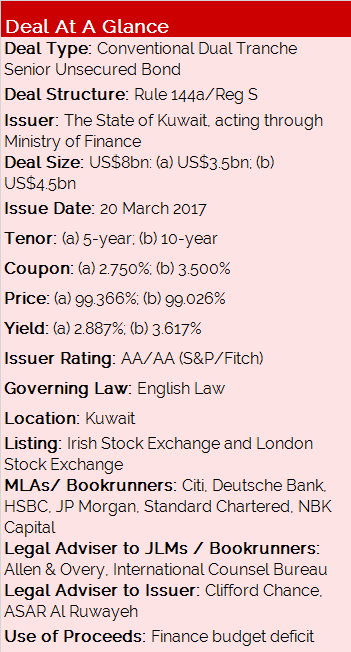 Background
Background
In March 2017 Kuwait was looking to tap the international debt markets for the first time, following the footsteps of a host of GCC sovereigns looking to fill a budget deficit induced by a spell of low oil prices.
On 20 March, the GCC state made its debut on the international debt capital markets with largest ever dual-tranche offering from any emerging market, a transaction that was over 3 times oversubscribed with the orderbook peaking at US$29bn.
The issuance was timed to launch ahead of the US Federal Reserve meeting, which was widely expected to lead to a rate hike and push yields up worldwide, so Kuwait used the opportunity to lock in lower yields.
Transaction Breakdown
On 3 March, the State of Kuwait announced a series of investor meetings in London and the US, to commence on 6 March. During a two-day roadshow in London and additional one-day meetings in New York, Boston, and Los Angeles, and coinciding with the UAE open, the order books were formally opened with initial price thoughts of T+100bp area for the 5-year tranche and T+120bp area for the 10-year.
The deal received remarkable interest, with orderbooks having surpassed US$15bn by 11:00 UK time, at which point a book size update was released to the market.
By the time the US market opened, the orderbook had grown further surpassing US$20bn, at which point price guidance of T+85bp and T+110bp were released to the market.
With US orders taken, the orderbook peaked in the region of US$29bn, making it largest ever orderbook in an emerging market dual-tranche deal and second largest orderbook from a GCC issuer.
The final spreads were set at 14:45 UK time, with syndicates indicating an expected total deal size of US$6-8bn.
The transaction ultimately launched and priced at a total deal size of US$8bn, inside of final price guidance levels at T+75bp for a US$3.5bn 5-year tranche and T+100bp for a US$4.5bn 10-year tranche. This represented a tightening of 25bp and 20bp, respectively, versus initial price thoughts.
European investors led on the 5-year tranche, whereas over half of the 10-year tranche went to US-based accounts, with asset managers taking 65% of the total deal on aggregate.
Nearly half (46%) of the 5-year tranche was allocated to accounts in Europe; 26% was placed with local MENA investors, a further 24% to the Americas and 4% distributed to Asia.
Asset managers composed 60% of all participants on the 5-year tranche, with banks picking up another 22%, SSAs taking 13% and the remaining 5% of the notes allocated to insurance and pension funds.
About 51% of the 10-year tranche was placed with accounts based in the US, 26% of the notes went to MENA accounts, 19% to accounts in Europe and the final 4% to Asia.
Asset managers picked up the majority of the 10-year notes at 68%, followed by banks (25%), SSAs (3%) and insurance & pension funds (4%).









